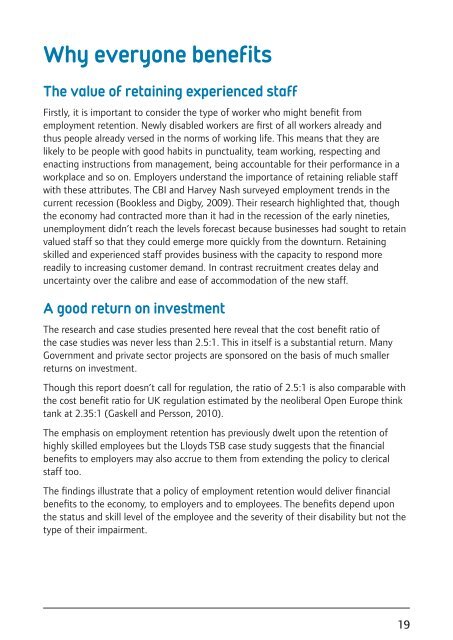Vocational rehabilitation The business case for retaining newly disabled staff and those with a long-term health condition
Vocational rehabilitation The business case for retaining newly disabled staff and those with a long-term health condition
Vocational rehabilitation The business case for retaining newly disabled staff and those with a long-term health condition
You also want an ePaper? Increase the reach of your titles
YUMPU automatically turns print PDFs into web optimized ePapers that Google loves.
Why everyone benefits<br />
<strong>The</strong> value of <strong>retaining</strong> experienced <strong>staff</strong><br />
Firstly, it is important to consider the type of worker who might benefit from<br />
employment retention. Newly <strong>disabled</strong> workers are first of all workers already <strong>and</strong><br />
thus people already versed in the norms of working life. This means that they are<br />
likely to be people <strong>with</strong> good habits in punctuality, team working, respecting <strong>and</strong><br />
enacting instructions from management, being accountable <strong>for</strong> their per<strong>for</strong>mance in a<br />
workplace <strong>and</strong> so on. Employers underst<strong>and</strong> the importance of <strong>retaining</strong> reliable <strong>staff</strong><br />
<strong>with</strong> these attributes. <strong>The</strong> CBI <strong>and</strong> Harvey Nash surveyed employment trends in the<br />
current recession (Bookless <strong>and</strong> Digby, 2009). <strong>The</strong>ir research highlighted that, though<br />
the economy had contracted more than it had in the recession of the early nineties,<br />
unemployment didn’t reach the levels <strong>for</strong>ecast because <strong>business</strong>es had sought to retain<br />
valued <strong>staff</strong> so that they could emerge more quickly from the downturn. Retaining<br />
skilled <strong>and</strong> experienced <strong>staff</strong> provides <strong>business</strong> <strong>with</strong> the capacity to respond more<br />
readily to increasing customer dem<strong>and</strong>. In contrast recruitment creates delay <strong>and</strong><br />
uncertainty over the calibre <strong>and</strong> ease of accommodation of the new <strong>staff</strong>.<br />
A good return on investment<br />
<strong>The</strong> research <strong>and</strong> <strong>case</strong> studies presented here reveal that the cost benefit ratio of<br />
the <strong>case</strong> studies was never less than 2.5:1. This in itself is a substantial return. Many<br />
Government <strong>and</strong> private sector projects are sponsored on the basis of much smaller<br />
returns on investment.<br />
Though this report doesn’t call <strong>for</strong> regulation, the ratio of 2.5:1 is also comparable <strong>with</strong><br />
the cost benefit ratio <strong>for</strong> UK regulation estimated by the neoliberal Open Europe think<br />
tank at 2.35:1 (Gaskell <strong>and</strong> Persson, 2010).<br />
<strong>The</strong> emphasis on employment retention has previously dwelt upon the retention of<br />
highly skilled employees but the Lloyds TSB <strong>case</strong> study suggests that the financial<br />
benefits to employers may also accrue to them from extending the policy to clerical<br />
<strong>staff</strong> too.<br />
<strong>The</strong> findings illustrate that a policy of employment retention would deliver financial<br />
benefits to the economy, to employers <strong>and</strong> to employees. <strong>The</strong> benefits depend upon<br />
the status <strong>and</strong> skill level of the employee <strong>and</strong> the severity of their disability but not the<br />
type of their impairment.<br />
19


